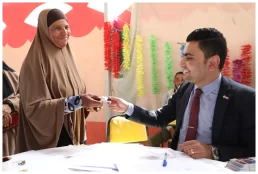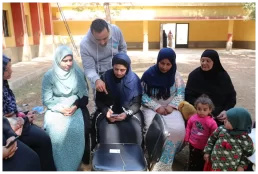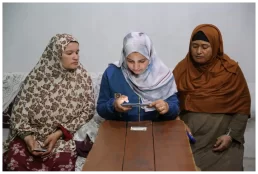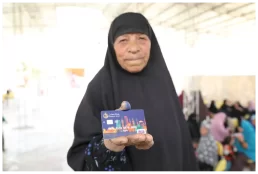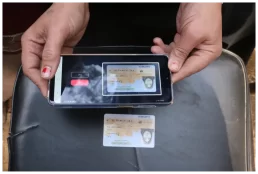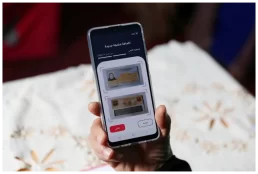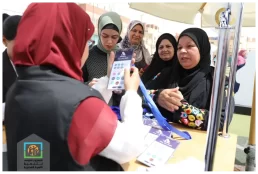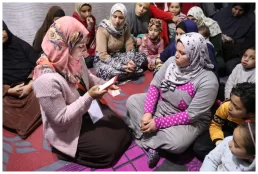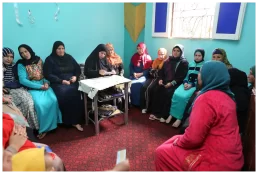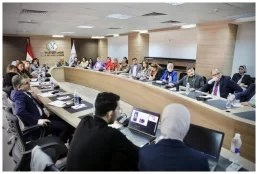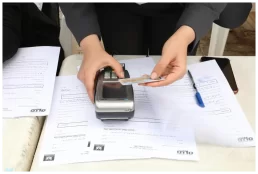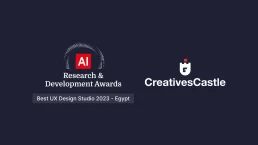Case Study: Digitalization of Village Savings and Loans Associations (VSLAs) in Egypt
Mobile App • Web App
This case study delves into CreativesCastle's partnership with the National Council for Women (NCW) and various stakeholders in Egypt to digitize Village Savings and Loans Associations (VSLAs). Discover how our UX design expertise transformed traditional financial practices into cutting-edge digital solutions, empowering rural women and fostering financial inclusion.
In the mission to promote financial inclusion and empower women economically, the Central Bank of Egypt has collaborated with the National Council for Women (NCW) and partnered with UN Women through the Financial Inclusion Program. Their goal is to transform the landscape of Village Savings and Loans Associations (VSLAs) in Egypt. This project, jointly led by NCW and the Central Bank of Egypt (CBE), is supported by UN Women Egypt and co-funded by the European Union and the Kingdom of the Netherlands. Its focus is on overcoming barriers to women's financial inclusion and economic empowerment by scaling up and digitizing a successful initiative known as Village Savings and Loans Associations (VSLAs) for women.
Together, they have introduced the "Tahwisha" application, a digital platform tailored for rural women. "Tahwisha," an Arabic colloquial term for "Saving," is not just an app; it serves as a catalyst for change, positively impacting the lives of 1.2 million women across 13 governorates.
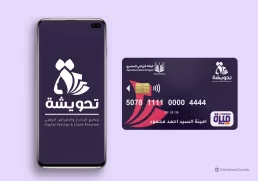
The Challenge
At the heart of this transformation is CreativesCastle, entrusted with the mission to digitize the VSLA model while preserving its essence. The objective was clear: To craft an innovative platform that seamlessly scales the VSLA model while preserving its core tenets of self-management and self-governance. The goal was to empower rural women by providing them with modern financial tools while retaining the spirit of self-management and self-governance that defined the VSLA model.
The "Tahwisha" project seeks to empower women in Egyptian villages by assisting women in establishing income-generating green activities or projects to improve the quality of life for their families. The National Council for Women is implementing the project through "financial facilitators," which are groups of women who have been trained to spread financial culture and raise women's capabilities through weekly sessions that tackled financial education and social and economic empowerment training for 52 weeks. The financial facilitators were approved as agents of the Agricultural Bank of Egypt under the Central Bank of Egypt's license.
It aims to expand the scale, sustainability, and impact of VSLAs through leveraging technology of different e-payment methods, thereby enhancing women’s access to financial services. In addition, the project will support small-scale women-led enterprises in rural areas.
The Transformation Journey
The journey of transforming VSLAs from their traditional foundations to a digitized landscape is a story of innovation, determination, and overcoming formidable challenges. VSLAs, though successful in fostering secure environments for savings and loans, faced limitations, including manual transactions, limited access to formal financial services, paper-based record-keeping, and a lack of digital literacy among members.
What is VSLA?
Village Savings and Loans Associations (VSLAs) are grassroots groups of people who meet regularly to save together and take small loans from those savings. They operate in cycles, usually one year long, after which savings and loan profits are distributed among members.
The purpose of a VSLA is to provide a simple, transparent, and accountable way to access financial services for communities who do not have ready access to formal financial services such as banks or microfinance institutions.
Understanding
Our journey towards transformation began with an extensive phase of identification and analysis. At CreativesCastle, we embarked on a deep dive into the world of VSLAs, conducting a thorough examination of their inner workings. Our primary objective was to establish a clear understanding of what we needed to create and why it was essential. This stage was crucial in answering fundamental questions such as the purpose behind the product's existence, its target audience, and the specific business challenges it aimed to address.
To achieve this clarity, we conducted a series of stakeholder meetings where our product designers engaged in in-depth conversations. These discussions were instrumental in crafting a foundational approach that harmonized with our overarching business strategy. As a result of this initial kick-off meeting, we emerged with a set of specifications to guide our work. Additionally, we created low-fidelity concept sketches, providing us with a basic yet essential outline to serve as a stepping stone for the next phase of the project.

Research
In the second phase of the transformation journey, our design team embarked on a journey to gain profound insights into our users and their needs.
→ User research/Market research:User research and market research played integral roles in this phase. User research took various forms, including interviews, surveys, and focus groups. These methods enabled us to engage directly with our target audience, ensuring that their voices and perspectives were heard.
Market research, on the other hand, encompassed a broader perspective, encompassing industry trends and competitive analysis. This wider view helped us contextualize our product within the larger market landscape and identify opportunities for innovation and differentiation.
→ User Interviews:CreativesCastle conducted extensive one-on-one interviews with both rural women and facilitators. These interviews allowed the team to establish personal connections with users, hear their stories, and understand their financial challenges.
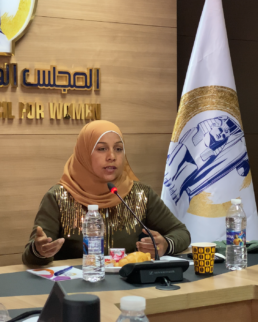
→ Co-Creation Workshops:The UX team didn't stop at interviews; CreativesCastle conducted interviews with key stakeholders including representatives from the Central Bank of Egypt (CBE), and the National Council for Women (NCW), to understand their objectives, expectations, and desired outcomes from the "Tahwisha" app. These conversations allowed the design team to align the app's features and functionalities with the broader goals of financial inclusion and empowerment.
Collaborative workshops were organized with stakeholders to foster a sense of partnership and shared vision. These workshops facilitated open discussions, idea sharing, and the co-creation of strategies to achieve project milestones. By actively involving stakeholders, CreativesCastle ensured that the app not only met user needs but also addressed the strategic objectives of the organizations involved.
→ Pain Point Identification:Identifying pain points was a central focus of the research. CreativesCastle systematically documented the challenges faced by rural women in managing their savings and loans, as well as the facilitators' struggles in administering the VSLAs. This process involved creating detailed pain point maps that visualized the journey of both user groups, highlighting areas where the "Tahwisha" app could offer solutions.

"Working with CreativeCastle was such a blessing. I have never seen in my professional life such dedication, perseverance, attention to detail, responsiveness, and adaptability. The quality of work was beyond my expectations. I always felt safe during our long-hour discussions, being sure that deadlines will be met, and quality will not be compromised."
— Osama Abdou, Program Director-VSLA | Financial Inclusion Department at Central Bank of Egypt.
Quick Facts
Based on our comprehensive research, we uncovered a wealth of insights that have provided us with a profound overview of the society in Egypt. Our user research, market analysis, and engagement with various stakeholders illuminated key societal trends, challenges, and opportunities.
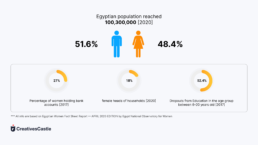
These findings not only deepened our understanding of the diverse needs and aspirations of the Egyptian population but also shed light on the broader socio-economic landscape. Armed with this knowledge, we are better equipped to design solutions that are not only responsive to individual user needs but also mindful of the intricate fabric of Egyptian society as a whole.
Creating User Personas
Based on the research findings, CreativesCastle developed detailed user personas representing different segments of the target audience. Creating diverse personas with a wide range of aspects posed a unique challenge due to the multifaceted nature of their interactions with the "Tahwisha" project. While some personas primarily engage with the app, others focus on the Management Information System (MIS), introducing varying perspectives and priorities.
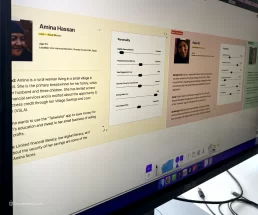
Tailoring personas to represent rural women, who may have limited digital literacy and distinct financial needs, presented another layer of complexity. Nonetheless, this comprehensive approach ensures that the project is attuned to the unique requirements of each persona, fostering a user-centered design that maximizes the impact of the "Tahwisha" initiative.
Journey Mapping
Journey mapping was another critical activity. The UX team mapped out the entire user journey, from the moment a rural woman first heard about the VSLA program to her ongoing interactions with the "Tahwisha" app. This exercise helped identify touchpoints where user experience improvements were needed and ensured that the app addressed users' needs at every stage.
Armed with insights from the analysis, CreativesCastle embarked on conceptualizing and designing the digital solution. This phase involved envisioning the "Tahwisha" application, which would serve as a comprehensive platform for VSLAs, streamlining their operations and empowering their members. The design aimed to be culturally sensitive and accessible to users with varying levels of digital literacy.
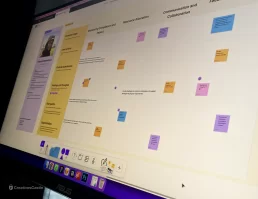
"From technology perspective; we were keen to build this platform with the latest technologies and to make sure from the scalability and reliability to serve this large number of users. In this context I'd like to send big thanks to our partner CreativesCastle who made this great user experience with deep studying for the user journey and different scenarios for each stakeholder in a very attractive and efficient way."
— Mohamed Abd Elwahab, Head of Business Solutions, and Technology at eAswaaq misr.
Conceptualization and Design
Before diving into the actual design, CreativesCastle created wireframes and prototypes. This iterative process allowed for quick and cost-effective testing of design ideas and functionalities. It helped identify potential usability issues early in the development phase, saving time and resources in the long run.
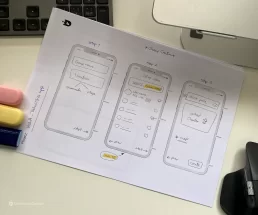
From Lockboxes to NFC Bracelets
The conventional system relied on a lockbox secured with three keys, which was used to safeguard the financial assets of the group. This cash box could only be opened during meetings when all key holders and at least two-thirds of the members were present.
While this system had some security measures in place, it posed logistical challenges and relied heavily on physical presence. Transitioning from this analog approach to a digital one involved not only technological advancements but also a shift in mindset within the VSLA community.

Enhancing Security through "Tap to Phone" Technology
To address these challenges and enhance security, Tahwisha introduced a transformative feature called "Tap to Phone" using NFC technology enabled by payment solution provider WIZZIT. Now, at least two out of the three Group managers are equipped with NFC bracelets that enable them to start the meeting or any savings or lending session by simply tapping their bracelets. This innovative approach not only streamlines the authorization process but also significantly improves security, ensuring that transactions are executed with the utmost transparency and accountability.
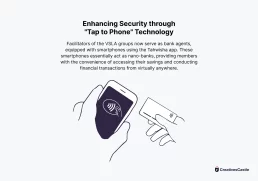
Facilitators of the VSLA groups now serve as bank agents, equipped with smartphones using the Tahwisha app. These smartphones essentially act as nano-banks, providing members with the convenience of accessing their savings and conducting financial transactions from virtually anywhere. This transition from physical lockboxes to digital banking represents a substantial leap in security, accessibility, and financial empowerment for VSLA members.
Overcoming the challenge involved not only technical expertise but also effective communication and training to ensure that VSLA members fully embraced and trusted this innovative solution, ultimately enhancing the security and efficiency of their financial interactions.
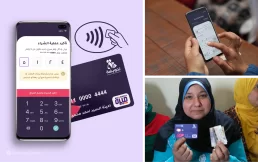
Testing and Iteration
Throughout the project, CreativesCastle established feedback loops with users. Prototypes and early versions of the app were tested regularly with real users. Their feedback and suggestions were incorporated into the design, ensuring that the final product addressed their pain points and preferences.
→ Usability testing:Usability testing also played a pivotal role in this phase. It offered us direct feedback from users, providing invaluable insights into what aspects of our product worked well and where improvements were needed. By incorporating both qualitative and quantitative data, we aimed to refine our design to align more closely with user expectations and preferences.
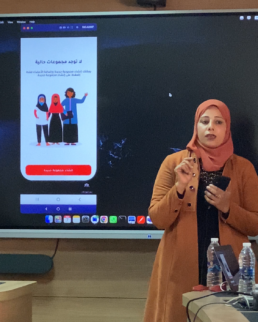
By conducting these in-depth activities, CreativesCastle created an app experience that not only met functional needs but also resonated with users on a personal and emotional level, ultimately driving the project's success in empowering marginalized communities through digital financial inclusion.
Collaborative Partnerships
The transformation process was a remarkable journey of collaboration and synergy. At its heart was the NCW Team in partnership with UN Women within the Financial Inclusion Program, led by Mr. Amr Soliman — a board member of the NCW and chair of its Economics committee, who played a pivotal role in guiding the project's strategic direction. The expertise of Ms. Angie Al-Yamani — National Manager of the National Financial Inclusion program at the National Council for Women, added invaluable insights and vision to the endeavor. Furthermore, the partnership was fortified by the commitment of Mr. Osama Abdou — Program Director at the Central Bank of Egypt, whose guidance ensured regulatory alignment and the project's overall success.
Notably, one of the key partners in this project was e-Finance, Egypt’s leading digital payment service provider. eAswaaq misr — a subsidiary of eFinance — will automate the system for managing digital lending and savings groups within the Tahwisha project. This automation empowers facilitators, the women overseeing project implementation, to leverage financial technology and utilize electronic payment techniques via mobile phones with the Tap to Pay feature. Moreover, e-Cards — a subsidiary of eFinance — will equip the project with contactless feature cards, enabling these dedicated women supervisors to streamline lending and savings operations effectively.
Alongside them, are the visionary leaders of CreativesCastle, Nader Amer — Founder & Head of Design, and Dina Tareq — Co-founder & Design Lead, who spearheaded the digitalization of VSLAs with unwavering dedication. This collaborative effort exemplifies how transformative initiatives can thrive through the collective expertise, determination, and shared vision of exceptional individuals and organizations.
CreativesCastle Deliverables
Stakeholder’s interviewsContextual market researchUser personas through a JTBD frameworkUser journey mapUser flow mapsUI design prototypeDesign system
"At CreativesCastle, we are driven by the belief that innovative design can truly make a difference in people's lives. Our journey in transforming VSLAs in partnership with exceptional organizations and individuals has been both inspiring and rewarding. We are proud to have played a pivotal role in enhancing financial empowerment for rural women."
— Nader Amer, Founder & CEO at CreativesCastle
Management Information System (MIS)
In addition to the application, we recognized the crucial need for a robust Management Information System (MIS). We developed this MIS to facilitate decision-making, enhance coordination, exercise control, and provide an in-depth analysis of the Tahwisha App's performance.
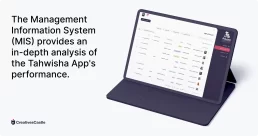
→ Benefits of MIS Integration
The integration of the Management Information System (MIS) into the Tahwisha App brought forth several notable benefits for the NCW through enabling real-time monitoring of the uptake and performance of Individuals and Groups, offering the National Council for Women (NCW) an invaluable tool for full control and oversight. It was a pivotal step in ensuring its success and providing the NCW with the tools needed to make a meaningful impact on rural women's financial empowerment.
Streamlining the Onboarding Experience
Enrolling 1.2 million women into the app posed a formidable challenge. CreativesCastle's UX team met this challenge head-on by engineering a streamlined onboarding process powered by NFC technology, drastically reducing enrollment time. User-friendly interfaces for data input during onboarding were meticulously designed to ensure a seamless user experience.
Consider the following contrasting scenario that illustrates the difference between manual and digitized onboarding processes:
→ Manual Onboarding:In the traditional method, onboarding was a time-intensive endeavor, with each individual requiring roughly 3 minutes for successful enrollment. When extrapolating this process to accommodate 1.2 million women, the sheer magnitude of the challenge became evident. Calculating the total time needed to onboard all participants revealed an astonishing 3.6 million minutes, equivalent to over 5,000 days. Managing this extensive task would require a team of 56 agents over a 3-month period.
→ Digitized Onboarding:The digitized onboarding process, empowered by innovative NFC technology, heralded a revolutionary efficiency shift. With the capability to complete onboarding in under 1 minute per individual, the cumulative time for all 1.2 million women was significantly reduced to 1.2 million minutes, approximately 1666.67 days. Impressively, this translated to a need for just 19 agents over a 3-month duration.
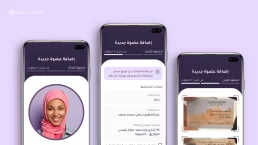
This digitization was made possible by using the technology of an Egyptian-based company called Valify, specializing in digital identity verification. Valify’s National ID OCR technology was used to digitize the document verification and automatic data extraction steps, which helped to make the National ID information collection simpler, quicker, and much more accurate. Overall, this greatly reduced onboarding time and the possibility of human errors.
By digitizing the onboarding process and considering agents' work hours, the number of agents required to complete the exercise in this example scenario over a span of 3 months can be reduced from 56 agents to 19 agents. This further demonstrates how digitization significantly enhances efficiency by allowing a smaller team of agents to manage the workload within their daily working hours.
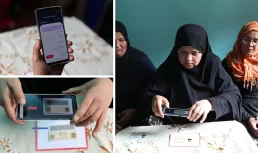
Preserving Core VSLA Elements
Creating a successful digital solution for the VSLA involved carefully considering the core elements that contribute to the success of Savings Groups, and ensuring that these principles were integrated into the app's design and functionality. These elements include:
→ Self-Selection:Tahwisha respects the principle of self-selection by allowing groups to choose their own members, group names, and stock prices.
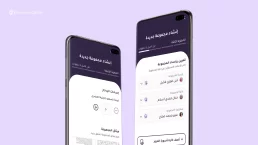
→ Democratic Governance:In alignment with the democratic governance approach of Savings Groups, the app facilitates the open election process for selecting the management committee. This ensures that anyone within the group can be nominated and voted for, promoting inclusivity and active participation among all members.
→ Accurate Record Keeping:Accurate record keeping is a cornerstone of successful Savings Groups. The app's record-keeping feature allows for the recording of every transaction during group meetings. This ensures that all members have real-time access to their savings and loan information, contributing to financial transparency and accountability.
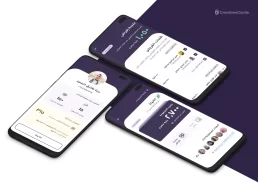
The Impact
The digitization of Village Savings and Loans Associations (VSLAs) has had a profound impact on the facilitators who play a crucial role in managing these groups. Here are the key ways in which the app has influenced their work:
1. Impact on Facilitators:
The digitization of Village Savings and Loans Associations (VSLAs) has had a profound impact on the facilitators who play a crucial role in managing these groups. Here are the key ways in which the app has influenced their work:
• Streamlined Group Management: Facilitators now have access to user-friendly digital tools that streamline group management tasks. This has reduced the administrative burden and made their roles more efficient.
• Enhanced Financial Literacy: The app provides facilitators with valuable financial data and insights, improving their financial literacy. They can now make more informed decisions and offer better guidance to VSLA members.
• Improved Accountability: The digital record-keeping system has enhanced accountability among facilitators. They can accurately track financial activities, ensuring transparency and trust within the groups.
• Empowerment Through Technology: Facilitators are now empowered with smartphones equipped with Near-Field Communication (NFC) technology, allowing them to manage group activities securely and efficiently. This transition from manual processes to digital technology has elevated their capabilities.
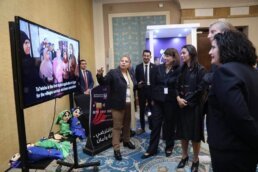
2. Impact on Rural Women:
The digitalization of VSLAs has had a profound impact on rural women, the primary beneficiaries of this initiative. Here are the key ways in which the app has positively influenced their lives:
• Financial Empowerment: Rural women now have access to secure digital group accounts, which has empowered them financially. This has led to a 35% increase in household savings, promoting financial security.
• Extended Financial Opportunities: With secure group accounts and improved financial management, rural women can access larger loans and benefit from extended repayment periods. This has opened up new economic opportunities for them.
• Enhanced Access to Banking Services: The direct linkage of VSLAs with formal banking services has expanded rural women's access to financial resources and banking services, bridging the gap between traditional banking systems and mobile wallets.
• Improved Security and Transparency: The adoption of Near-Field Communication (NFC) technology has increased the security of financial transactions, ensuring that funds are handled transparently and accountably.
• Simplified Onboarding: Rural women now experience a simplified onboarding process, thanks to digital technology. This reduces the time and effort required to join VSLAs, making it more accessible for new members.
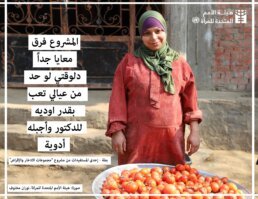
"The project really benefited me, now when one of my kids get sick I take him to the doctor and buy him medicine"
— Bata, one of The Village Savings and Loans Associations (VSLA) beneficiaries.
3. Impact on Business and Economy:
The digitization of VSLAs has not only benefited rural women and facilitators but has also had a significant impact on the broader business and economic landscape:
• Collateral from Transactional Data: The accumulation of transactional data by VSLAs has created valuable collateral for digital credit extensions, fostering economic growth in marginalized communities.
• Enhanced Banking Connectivity: The direct linkage of VSLAs with formal banking services has improved the overall business ecosystem. It has created new opportunities for financial institutions to engage with underserved populations.
• Transition from Limited to Comprehensive Financial Records: The digital system's ability to accumulate a financial history for each group and participant has facilitated access to credit and financial services, boosting economic activity.
• Replacing Traditional Methods: The transition from manual processes and physical containers to digital technology and formal banking institutions has modernized the financial landscape in these communities. This shift enhances efficiency and security in financial operations.
• Stakeholder Benefits: The project has brought significant benefits to stakeholders like the National Council for Women (NCW). They now have a full and clear overview of all group activities, thanks to the Management Information System (MIS) integrated into the digital platform. This enhanced transparency and oversight enable better decision-making and ensure that the project aligns with its strategic objectives.
The digitization of VSLAs represents a multifaceted impact that touches the lives of rural women, facilitators, businesses, and the broader economy, ushering in a new era of financial empowerment and inclusivity.
"CreativesCastle's dedication to creating meaningful design solutions was at the core of our involvement in the VSLA project. It's been an incredible journey of collaboration and innovation. We are deeply honored to have contributed to the empowerment of rural women and the growth of these communities. This project underscores the power of design to drive positive change and transformation."
— Dina Tareq, Co-founder & Design Lead at CreativesCastle
Conclusion
This project serves as a remarkable case study in the intersection of UX design and financial empowerment, showcasing how technology can drive positive change in marginalized communities.
In summary, the digitalization of VSLAs in Egypt not only addresses longstanding challenges but also opens new doors to financial empowerment, resilience, and community support. It exemplifies how collaboration, innovation, and a deep commitment to preserving core values can drive transformative change.
CreativesCastle's UX efforts in the digital transformation of VSLAs in Egypt exemplify the studio's commitment to user-centric design and innovative solutions. By understanding the user, creating user personas, conducting usability testing, and prioritizing accessibility, CreativesCastle played a pivotal role in the success of the "Tahwisha" app.
FAQ
Q. What role did CreativesCastle play in the digitalization of VSLAs in Egypt? CreativesCastle played a pivotal role in the digital transformation of VSLAs in Egypt. We were entrusted with the mission to digitize the VSLA model while preserving its essence. Our objective was to craft an innovative platform that seamlessly scales the VSLA model while preserving its core tenets of self-management and self-governance. For more information on our services, visit our Services page.
Q. How did CreativesCastle approach user research for the VSLA digitalization project? Our approach to user research was thorough and comprehensive. We conducted a series of stakeholder meetings and one-on-one interviews with rural women and facilitators. Additionally, we engaged in collaborative workshops with key stakeholders to ensure that the app aligned with both user needs and the broader goals of financial inclusion and empowerment.
Q. What were the main challenges CreativesCastle faced during the digitalization of VSLAs? The digitalization of VSLAs presented several challenges, including transitioning from manual to digital processes, enhancing security, and streamlining onboarding for 1.2 million women. Overcoming these challenges required a combination of technological expertise, effective communication, and innovative solutions. To understand how we tackle challenges, check out our Process page.
Q. What were the key achievements of the digitalization project led by CreativesCastle? The project resulted in rapid financial inclusion, heightened resilience with extended savings cycles, and the accumulation of transactional data for economic growth. It also improved liquidity and access, enhanced security with NFC technology, and streamlined onboarding for 1.2 million women. To learn more about our successful projects, visit our Portfolio page.
Q. How can businesses benefit from CreativesCastle's expertise in UX design and digital transformation? CreativesCastle's expertise in UX design and digital transformation can help businesses succeed by providing tailored solutions to specific challenges. Whether it's improving user interfaces, streamlining processes, or enhancing digital security, our team can drive positive change and innovation. Feel free to contact us for detailed estimations for your project. To get in touch, visit our Contact page.
